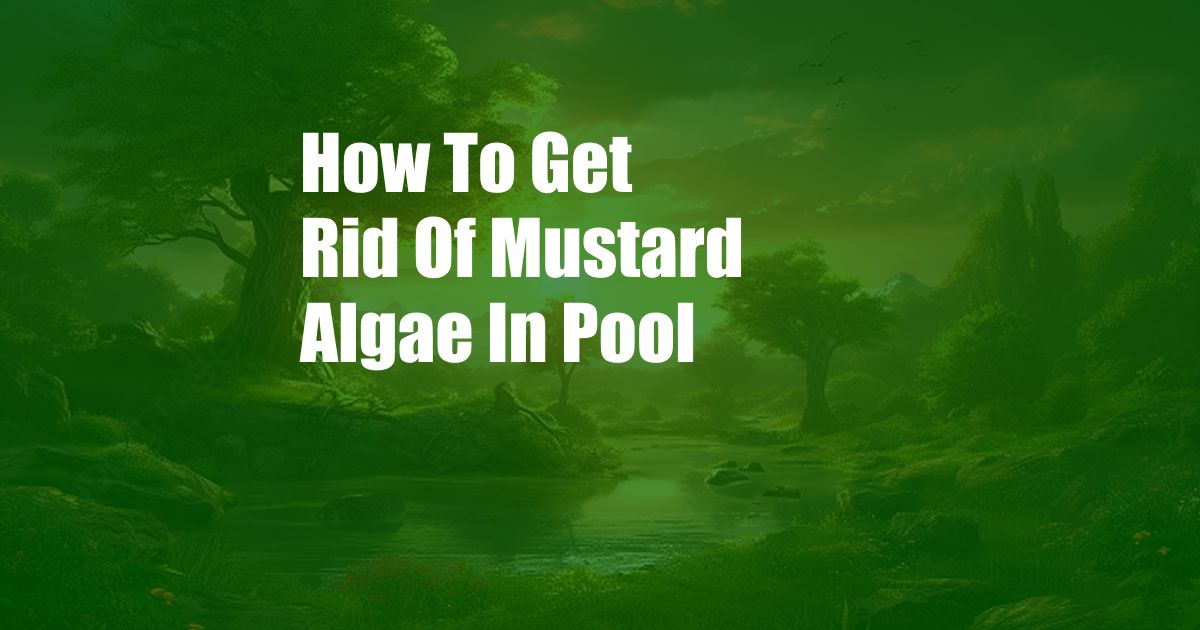
<h2>How to Eliminate Mustard Algae and Restore a Shimmering Pool</h2>
<p>Picture this: you walk out to your backyard, eager to take a refreshing dip in your crystal-clear pool. But instead, you're met with a cloudy, mustard-colored nightmare. Mustard algae, a notorious culprit of pool woes, has taken hold. Fear not, fellow pool owners! This guide will equip you with the knowledge and strategies to wage war on mustard algae and restore your pool's pristine glory.</p>
<p>Step into the world of algae, where microscopic plant life can wreak havoc on your aquatic paradise. Mustard algae, a specific strain of algae, thrives in warm, alkaline conditions. Its telltale yellow-mustard hue stems from the production of pigments called carotenoids, providing a distinctive and unwelcome presence in your pool.</p>
<h3>The Virulent Invader: Mustard Algae</h3>
Mustard algae is a persistent foe that poses several vexing challenges. Its thick, slimy coating clings tenaciously to pool surfaces, making it difficult to remove. The algae's resilience stems from its ability to develop a protective barrier against chlorine, the primary disinfectant in most pools. This barrier renders chlorine ineffective, allowing mustard algae to flourish even in properly chlorinated water.
<p>The consequences of mustard algae infestation extend beyond aesthetics. The algae's presence can irritate skin and eyes, making it uncomfortable and unsafe to swim. Its buildup can also clog filters and pumps, leading to reduced water circulation and compromised water quality.</p>
<h3>Waging War on Mustard Algae: A Six-Step Approach</h3>
Eradication of mustard algae requires a comprehensive and strategic approach. The following six steps provide a thorough guide to vanquish this aquatic nemesis and restore your pool's pristine condition.
<ol>
<li><strong>Test and Adjust Water Chemistry:</strong> Ensure optimal water chemistry by testing chlorine, pH, and alkalinity levels. Adjust chlorine levels to 3-5 ppm, pH to 7.2-7.8, and alkalinity to 100-150 ppm.</li>
<li><strong>Shock the Pool:</strong> Release a high concentration of chlorine (10-15 ppm) into the pool by adding liquid chlorine or chlorine granules. This will destroy most mustard algae and prevent its spread.</li>
<li><strong>Brush and Vacuum:</strong> Use a stiff brush to dislodge algae from pool surfaces. Vacuum the pool thoroughly to remove loosened algae and debris.</li>
<li><strong>Treat with Algaecide:</strong> Add a non-metallic algaecide specifically designed to target mustard algae. Follow the manufacturer's instructions carefully.</li>
<li><strong>Maintain Regular Chlorine Levels:</strong> Continue to maintain chlorine levels at 3-5 ppm to prevent algae growth. Regular chlorine dosing will inhibit mustard algae's ability to establish a foothold.</li>
<li><strong>Prevent Future Outbreaks:</strong> Implement preventative measures such as keeping the pool covered when not in use, maintaining proper water chemistry, and regularly cleaning pool surfaces and equipment.</li>
</ol>
<h3>Tips and Expert Advice from the Trenches</h3>
<p>In addition to the six-step approach outlined above, here are some additional tips and expert advice to bolster your mustard algae eradication efforts:</p>
<ul>
<li><strong>Use a Phosphate Remover:</strong> Phosphates provide nutrients for algae. Adding a phosphate remover to your pool will help control algae growth.</li>
<li><strong>Circulate the Pool Water:</strong> Ensure adequate water circulation by running the pump for at least 10-12 hours per day. This will distribute chlorine throughout the pool and prevent the formation of stagnant areas where algae can thrive.</li>
<li><strong>Avoid Overcrowding:</strong> Too many swimmers in the pool can contribute to algae growth due to increased bather waste. Limit the number of swimmers in the pool at any given time.</li>
</ul>
<h3>Mustard Algae FAQ</h3>
<p><strong>Q: Why is mustard algae hard to kill?</strong></p>
<p>A: Mustard algae has a protective barrier that makes it resistant to chlorine. It also reproduces quickly, making it difficult to fully eradicate.</p>
<p><strong>Q: What is the best algaecide for mustard algae?</strong></p>
<p>A: Look for a non-metallic algaecide specifically designed to target mustard algae. Follow the manufacturer's instructions carefully.</p>
<p><strong>Q: How long does it take to get rid of mustard algae?</strong></p>
<p>A: The time frame varies depending on the severity of the infestation. With consistent treatment, you can usually remove most mustard algae within 3-5 days.</p>
<h3>Conclusion</h3>
The battle against mustard algae can be daunting, but with the knowledge and strategies outlined in this guide, you can vanquish this pool invader and restore your swimming paradise. Remember to test water chemistry, shock the pool, brush and vacuum diligently, and use the expert advice provided. Are you ready to say goodbye to mustard algae and reclaim the crystal-clear pool you crave? Join the fight today and let your pool shimmer once more.
